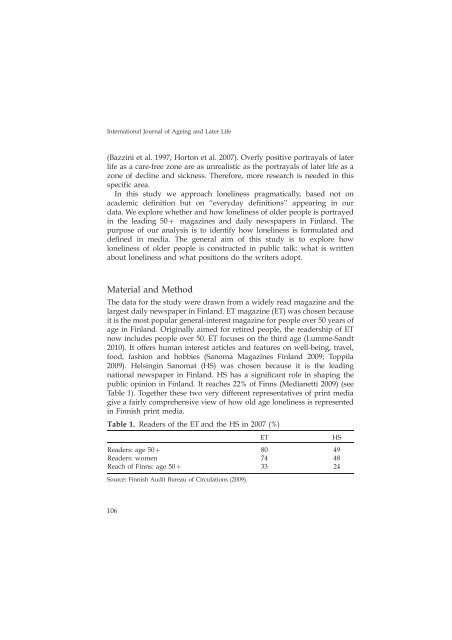Avaa tiedosto - TamPub - Tampereen yliopisto
Avaa tiedosto - TamPub - Tampereen yliopisto
Avaa tiedosto - TamPub - Tampereen yliopisto
You also want an ePaper? Increase the reach of your titles
YUMPU automatically turns print PDFs into web optimized ePapers that Google loves.
International Journal of Ageing and Later Life<br />
(Bazzini et al. 1997; Horton et al. 2007). Overly positive portrayals of later<br />
life as a care-free zone are as unrealistic as the portrayals of later life as a<br />
zone of decline and sickness. Therefore, more research is needed in this<br />
specific area.<br />
In this study we approach loneliness pragmatically, based not on<br />
academic definition but on ‘‘everyday definitions’’ appearing in our<br />
data. We explore whether and how loneliness of older people is portrayed<br />
in the leading 50 magazines and daily newspapers in Finland. The<br />
purpose of our analysis is to identify how loneliness is formulated and<br />
defined in media. The general aim of this study is to explore how<br />
loneliness of older people is constructed in public talk: what is written<br />
about loneliness and what positions do the writers adopt.<br />
Material and Method<br />
The data for the study were drawn from a widely read magazine and the<br />
largest daily newspaper in Finland. ET magazine (ET) was chosen because<br />
it is the most popular general-interest magazine for people over 50 years of<br />
age in Finland. Originally aimed for retired people, the readership of ET<br />
now includes people over 50. ET focuses on the third age (Lumme-Sandt<br />
2010). It offers human interest articles and features on well-being, travel,<br />
food, fashion and hobbies (Sanoma Magazines Finland 2009; Toppila<br />
2009). Helsingin Sanomat (HS) was chosen because it is the leading<br />
national newspaper in Finland. HS has a significant role in shaping the<br />
public opinion in Finland. It reaches 22% of Finns (Medianetti 2009) (see<br />
Table 1). Together these two very different representatives of print media<br />
give a fairly comprehensive view of how old age loneliness is represented<br />
in Finnish print media.<br />
Table 1. Readers of the ET and the HS in 2007 (%)<br />
ET<br />
HS<br />
Readers: age 50 80 49<br />
Readers: women 74 48<br />
Reach of Finns: age 50 33 24<br />
Source: Finnish Audit Bureau of Circulations (2009).<br />
106














